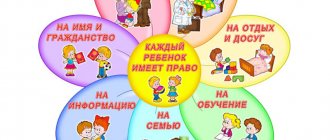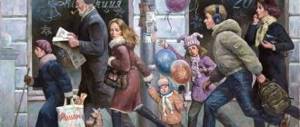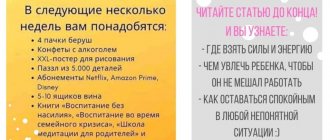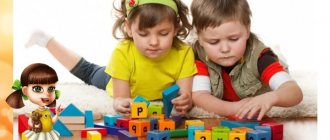Consultation for parents “Math at home”
"Learning math at home"
Consultation for parents
Prepared by Stolika S.E.
Goal: to introduce parents to playful ways to develop counting skills, logical thinking, and imagination.
“You can only learn through fun” French novelist Anatole France. We need to start by instilling in the child attention, the ability to compare and observe. Games help your child become more comfortable with mathematics. In the process of playing, children learn complex mathematical concepts, learn to count, read and write, and the closest people - his parents - help the child develop these skills. But it's not only a workout, it's also a great time spent with your own child. However, in the pursuit of knowledge, it is important not to overdo it.
The most important thing is to instill in the child an interest in learning. To do this, classes should be held in a fun way. The main thing when learning to count is not mastering computational skills at all, but understanding what numbers mean and what they are needed for. His knowledge will be stronger if you reinforce it at home. It is worth teaching a child before school to distinguish: - the spatial arrangement of objects (above, below, right, left, under, above, etc.); - recognize basic geometric shapes (circle, square, rectangle, triangle); -size of objects; - the concepts of “more”, “less”, “part”, “whole”.
Forms of teaching elementary mathematical concepts - games.
Game “On the contrary” (thick - thin, high - short, wide - narrow)
. Game “Guests have arrived” (determining, without counting, the equality and inequality of two groups of objects using the technique of superimposition). Use the terms “more”, “less”, “equally”. Make sure that the child does not count the same item twice.
Game “Name the Neighbors” (the adult names the number, and the child names his neighbors). For example, an adult says: “Two,” and a child says: “One, three.”
Game “Divide the object” (cake into 2, 4, etc. parts). Show that the whole is always greater than the part. It is advisable to limit the composition of problems to addition and subtraction in one action. Let the child take part in creating the problem himself. It is important to teach him to pose a question to a problem, to understand what kind of question can be the logical conclusion of the conditions of a given problem.
Game “Find a Pair” (in front of the child there are number cards in a row with objects drawn or pasted on them). The adult shows the number, and the child finds the corresponding card.
Game “What number is missing?” The missing number is called. Account on the way. Small children get tired very quickly in transport if they are left to their own devices. This time can be spent usefully if you count together with your child. You can count the passing trams, the number of child passengers, shops or pharmacies. You can come up with an object for everyone to count: the child counts the big houses, and you count the small ones. Who has more? How many cars are there around? Draw your child’s attention to what is happening around him: on a walk, on the way to the store, etc. Ask questions, for example: “Are there more boys or girls here?”, “Let’s count how many benches there are in the park,” “Show me which one is the tree is tall and which is the shortest”, “How many floors are there in this house?” Etc.
Balls and buttons
. Concepts of spatial arrangement are easily learned in playing with a ball: ball above your head (above), ball at your feet (below), throw to the right, throw to the left, back and forth. The task can be complicated: you throw the ball with your right hand to my right hand, and with your left hand to my left. In action, the baby learns many important concepts much better. How far is it? While walking with your child, choose an object not far from you, such as a staircase, and count how many steps there are to it. Then select another object and also count the steps. Compare the distances measured in steps - which is greater? Try to guess with your child how many steps it will take to get to some close object. Guess how many are in which hand. The game can be played by two or more players. The presenter picks up a certain number of items, no more than 10 (this could be matches, candies, buttons, pebbles, etc.), and announces to the players how many items he has. After that, he puts them in both hands behind his back and asks the children to guess how many objects are in which hand.
Counting in the kitchen.
The kitchen is a great place to learn the basics of math. The child can count serving items while helping you set the table. Or, at your request, take three apples and one banana out of the refrigerator. You can diversify tasks endlessly. Fold it into a square. Take thick paper of different colors and cut out squares of the same size from it - say, 10 x 10 cm. Cut each square along pre-drawn lines into several parts. One of the squares can be cut into two parts, the other into three. The most difficult option for a baby is a set of 5-6 parts. Now give the child sets of parts one by one, let him try to reconstruct a whole figure from them. All this will prepare the child well for studying in the 1st grade of school and will make it interesting and educational.
Literature: Kindergarten - family: aspects of interaction. A practical guide for methodologists, educators and parents. /Aut.-state Glebova SV. — Voronezh: TC “Teacher”, 2005 -111 pp. Nosova E. A. “Prelogical preparation of preschool children. Using game methods in the formation of mathematical concepts in preschoolers.” - L.: 1999.
Consultation for parents on FEMP. consultation (preparatory group) on the topic
Consultation for parents on FEMP.
In preschool age, the foundations of the knowledge a child needs in school are laid. Mathematics is a complex subject that can present some challenges during schooling. In addition, not all children have an inclination and have a mathematical mindset, therefore, when preparing for school, it is important that preschoolers have the following knowledge in mathematics when they start studying:
· counting to twenty in ascending and descending order, the ability to recognize numbers in a row and separately, quantitative (one, two, three...) and ordinal (first, second, third...) numerals from one to ten;
· previous and subsequent numbers within one ten, the ability to compose numbers of the first ten;
· recognize and depict basic geometric shapes (triangle, quadrangle, circle, oval);
· basics of measurement: a child must be able to measure length, width, height using a string or sticks;
· comparing objects: more - less, wider - narrower, higher - lower, longer - shorter.
The basis of the fundamentals of mathematics is the concept of number. However, number, like almost any mathematical concept, is an abstract category. Therefore, difficulties often arise in explaining to a preschooler what a number is.
In mathematics, it is not the quality of objects that is important, but their quantity. Operations with numbers themselves are difficult at first and not entirely clear to the child. However, you can teach children numeracy through specific subjects. The child understands that toys, fruits, and objects can be counted. At the same time, you can count objects “in between times.” For example, while walking, you can ask your child to count the objects you encounter along the way.
It is known that children really like doing small housework. Therefore, you can teach your child to count while doing homework together. For example, ask your child to bring you a certain amount of any items needed for the task. In the same way, you can teach your child to distinguish and compare objects: ask him to bring you a large ball or a tray that is wider.
Visualization is an important principle in a child’s learning.
When a child sees, feels, touches an object, teaching him mathematics is much easier. Therefore, one of the basic principles of teaching children the basics of mathematics is clarity. Make math aids because it is better to count certain objects, such as colored circles, cubes, strips of paper, etc. It’s good if you make geometric shapes for math classes, if you have games “Loto” and “Dominoes”, which also contribute to the formation of basic counting skills in children.
The school mathematics course is not at all easy. Children often experience various kinds of difficulties when mastering the school mathematics curriculum. Perhaps one of the main reasons for such difficulties is the loss of interest in mathematics as a subject. Consequently, one of the most important tasks of preparing a child for schooling will be to develop his interest in mathematics. Introducing a child to this subject in a family setting in a playful and entertaining way will help them in the future to quickly and easily master complex issues of the school course.
Let's play with the children
Account on the way.
Children get tired very quickly in transport if they are left to their own devices. This time can be spent usefully if you count together with your child. You can count the passing trams, the number of child passengers, shops or pharmacies. You can come up with an object for everyone to count: the child counts the big houses, and you count the small ones. Who has more?
How many cars are there around?
Draw your child’s attention to what is happening around him: on a walk, on the way to the store, etc. Ask questions, for example: “Are there more boys or girls here?”, “Let’s count how many benches there are in the park,” “Show me which one is the tree is tall and which is the shortest”, “How many floors are there in this house?” etc.
Balls and buttons.
Concepts of spatial arrangement are easily learned in playing with a ball: ball above your head (above), ball at your feet (below), throw to the right, throw to the left, back and forth. The task can be complicated: you throw the ball with your right hand to my right hand, and with your left hand to my left. In action, the baby learns many important concepts much better.
How far is it?
While walking with your child, choose an object not far from you, such as a staircase, and count how many steps there are to it. Then select another object and also count the steps. Compare the distances measured in steps - which is greater? Try to guess with your child how many steps it will take to get to some close object.
Guess how many are in which hand.
The game can be played by two or more players. The presenter picks up a certain number of items, no more than 10 (this could be matches, candies, buttons, pebbles, etc.), and announces to the players how many items he has. After that, he puts them in both hands behind his back and asks the children to guess how many objects are in which hand.
Counting in the kitchen.
The kitchen is a great place to learn the basics of math. The child can count serving items while helping you set the table. Or, at your request, take three apples and one banana out of the refrigerator.
Types of mathematics classes in the preparatory group
Pedagogy uses several types of activities to engage children in mathematical terms and rules. It is easier for children from the middle group to remember and assimilate information presented in the form of a game, which teachers successfully use.
Integrated activities in a playful way
During an integrated lesson, the teacher invites children to take a walk to the magical land of Mathematics, where he gives tasks in the form of a game. Integration is the process of introducing one thing into another; in this case, learning elements are inserted into the game.
How to teach children to draw correctly
During the lesson, children's curiosity is involved, the lesson is necessarily built on the positive. The entire journey across the country in Mathematics is divided into short segments of tasks of varying complexity; the teacher must complete the completion of each task with praise, expressed by the success of the group. With a sense of satisfaction, children increase their confidence in their abilities, are ready to cope with the next difficulties, and become interested in the process.
Integrated lesson on FEMP
Open classes
In open classes, there is an opportunity for parents of students to attend the lesson. Often such classes are also attended by colleagues of the teacher initiating the event. The goal is always to demonstrate the achievements of the students and the skill of the teacher.
Important! In such lessons, children are helped by a team feeling when they jointly achieve the goal set by the teacher at the very beginning of the lesson. In a team, everyone is liberated and is not afraid to speak out, make assumptions, and participate in the process.
Most teachers make the most common mistake - rehearsing an open lesson with their children. Such activities are not of particular interest to those present, because adults see that the children have memorized the answers. Incidents often happen when students confuse memorized answers and shout them out without waiting for the question. For a teacher, such a lesson is more likely to become a minus to professionalism than a plus.
In order for the event to be successful, it is enough to prepare a detailed plan so as not to miss important points and adjust the length of the lesson. Materials are prepared in advance: counting sticks, paper, glue sticks, scissors and everything that the students will need to solve the assigned problems. But the list of questions should not be known to the participants. Contemplation of the thought process is an invaluable picture in open lessons. Children who achieve results in front of the guests themselves enjoy learning and demonstrate the professional skills of a teacher.
Master classes from teachers
The undoubted usefulness of these classes lies in the fact that teachers share the secrets of simplifying some mathematical operations. The curriculum that teachers must follow in their lessons does not involve such tricks. Students are provided with strict information adopted by the Ministry of Education. However, there are many unofficial rules—tips that make solving many problems much easier; one such example would be multiplying a two-digit number by 11—the result will always be a three-digit number consisting of the digits of the first factor, between which their sum is enclosed.
Interesting! 23 multiplied by 11 is the result of 253, where 2 and 3 are the numbers from the first factor of 23, and the five standing between them is their sum.
There are similar tricks in geometry and in counting for preparatory groups. The most successful master class will be one that is based on the example of magic tricks. A lesson that surprises guests is the most successful. Curiosity and admiration for the operating rules and the results obtained can captivate even the weakest and most uninterested students.
Open lesson in a preparatory group on the surrounding world
Typically, such classes are conducted in the form of presentations. Concise information is placed on the slides, accompanied by verbal explanations, so that those present can note down interesting points.
Presentation and master class
Final lesson for middle group children
Summing up the results of the next year of children's development in a preschool institution, teachers conduct generalization classes. They take place in the spring, before the students go on vacation before the new school year. Such lessons help to draw a line under all the material studied, thanks to which the teacher understands how successfully he is carrying out his work throughout the year.
Important! The final classes necessarily cover all areas of knowledge acquired by the end of the year. Children must demonstrate understanding of all material learned.
According to the Federal State Educational Standard (Federal State Educational Standard), each age group has its own norms and amounts of knowledge, according to which, in each group, absolutely all children must learn a certain amount of information, regardless of the degree of ability of each student.
The lesson is based on excitement, using riddles, poems and songs. Similar to an integrated lesson, exercises can be performed during a game, where children apply their knowledge and move towards a goal, covering short distances from the proposed exercises.
Consultation for parents in kindergarten: “Mathematical development of children in the family”
On a bus or tram, you can often hear a child, encouraged by his mother or grandmother, declare that he can count to a hundred or a thousand. When he starts counting, he is in a hurry and misses the numbers. The adults give him hints, and the child mechanically repeats everything they say. Here there is a mechanical memorization of numerals, behind which there is no main thing - understanding the number. It is certainly necessary to teach preschoolers the basics of mathematics, but teaching must be structured in such a way that the child understands what he is learning, so that the world around him becomes clearer. Parents are called upon to help him with this: to show significant relationships and interdependencies, to teach him to reason, compare, contrast.
How should a child be taught to count? The simplest and most effective method is to count items. To do this, it is not necessary to organize special classes. When a child communicates with an adult, during children's games, there are many opportunities to practice counting. “How many trees grow near the house? How many flowers bloomed in the flowerbed? How many red cars are there in the parking lot? How many pencils are in the box? Bring five plates, five spoons. Place as many cups as there are people drinking tea.” If desired, an adult can ask the children many similar questions or give them tasks that will allow the children to practice counting.
When comparing two groups of objects, the adult should show the child how to transform unequal sets into equal ones by adding or removing one element. For example: we put 6 cubes in a row, and under them – 7 pebbles. We invite the child to determine what is more, what is less, pebbles or cubes, or an equal number of them. Having found out that there are fewer cubes than pebbles, you can invite the child to make sure that there are equal numbers of cubes and pebbles. It is important to take your time with the hint and give the child the opportunity to find the right solution. When completing a task, the child must not only give a clear answer, but also be able to give reasons for it and talk about how he came to this conclusion. The favorite ball game can also be used to strengthen children's mathematical knowledge. While walking, you throw a ball to your child and call out a number. The child, throwing the ball back, must name the number one more or one less, depending on how it was agreed. Thus, children learn the natural sequence of numbers: each subsequent number is one more than the previous one. In order to prepare for the study of addition and subtraction, it is necessary to introduce children to the composition of numbers from two smaller ones. To do this, you can use any objects of two colors: cubes, buttons, squares, etc. For example: put five red squares in a row. Count them. Then replace one red square with a blue one and count it like this: four red, one blue, and together five. Then replace another red square with a blue one and count again: three red and two blue, and together five. Replace another red square with a blue one and count: two red and three blue, and together five. And finally, replace another red square with a blue one, count: one red and four blue, and together five. Thus, all possible variants of the composition of the number five will be obtained: 4 and 1, 3 and 2, 2 and 3, 1 and 4. Thus, in games, children acquire ideas about the relationships between numbers, about equality and inequality, about the composition of a number from two smaller numbers, learn to justify their answers. In everyday life, we are often faced with the need to measure something. And these situations must be used to teach the child. Mom is preparing breakfast. The child is usually here, in the kitchen. Invite him to help you. “Let’s measure out 5 tablespoons of cereal for semolina porridge.” Pay the child's attention to the fact that the same amount of cereal should be poured into the spoon each time. In every family there are situations when you need to move something, change furniture. Use these moments for learning too. Child measured. “Will the cabinet fit where we want to move it? How to find out? – these kinds of questions confront the child with the need to solve a practical problem and awaken his mental activity. In similar situations, it is important to encourage the child to reason. By reasoning out loud, the child learns to think logically and make simple conclusions.
Obviously, the child will eventually come to the conclusion that he needs to try on whether the cabinet will fit in the place that was chosen for him. Adults can help him find an object to measure with and how to get the most accurate measurement. In life, we often face the need to share something. Children should be taught this. We recommend that you first show your child how to divide objects into two, four, or eight equal parts. Parents themselves can come up with a situation where the child will be faced with the need to divide. For example: a friend came to visit him, he wants to treat him, but there is only one apple. What to do? The children decide to split the apple. Here it is necessary to explain that it can be divided in different ways (after all, it can be divided not equally), but we need to divide it into two equal parts. After this, you carefully divide the apple, comparing both pieces, saying that they are the same, equal: “Two identical pieces, two equal parts.” This kind of exercise teaches the child to compare, contrast, reason logically, and draw appropriate conclusions and conclusions. And, therefore, they promote him in mental development. The main thing in teaching a child is not the amount of knowledge that you give him, but the developmental effect that will be obtained as a result of training. As a result of learning, the child should become smarter. If he has learned to think, reason, give answers meaningfully, justifying them logically, then you have achieved the desired result.
We recommend watching:
Scenario for a math holiday for kindergarten Consultation for kindergarten parents Consultation for kindergarten parents. Development of mathematical abilities in preschoolers Summary of a lesson in mathematics for preschoolers. Number and figure 5
Similar articles:
How to teach a child to count
Development of mathematical concepts of children of primary preschool age in the design process
GCD summary. Formation of elementary mathematical concepts in preschoolers
Mathematical KVN in the senior, preparatory group
Mathematical riddles for preschoolers in verse




